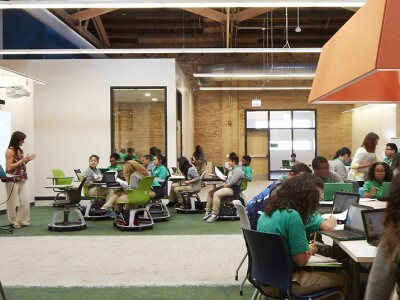Blended Learning on the Ground: Advice from College Educators
Topics

We’ve all had the experience of truly purposeful, authentic learning and know how valuable it is. Educators are taking the best of what we know about learning, student support, effective instruction, and interpersonal skill-building to completely reimagine schools so that students experience that kind of purposeful learning all day, every day.
Most college faculty recognize that lecturing alone is not an effective way to reach students. But how do you get started with blended learning?
By now I suspect most college faculty have heard of “blended learning, “hybrid learning,” and “flipped” classes. Some of us have experimented with these approaches ourselves; many more have learned of them indirectly from colleagues, the media, or our school-age children.
Most college faculty also recognize that lecturing alone is not an effective way to reach students. We want to get students actively engaged in learning by incorporating more formative assessment, group discussion, project work, and problem-solving into our courses. Blended learning offers a means for doing these things, but the level of advance preparation required can seem overwhelming.
So how do you get started?
Here are some suggestions from pioneering faculty who’ve shared their experiences at Bryn Mawr College’s annual Blended Learning in the Liberal Arts Conference:
- You don’t have to redesign your entire course all at once. Start small and build with each iteration. For example, you might initially develop four in-class activities paired with online homework exercises, and then add one or two more each time you teach the course. Starting with only one blended activity might not be worth the effort, since it won’t give you or your students a chance to get comfortable with the new format, but there’s no need to take a blended approach every day or even every week.
- Think about your pedagogical goals and pain points, and start with things that will give you the greatest return on your time investment. Are there concepts or skills students consistently struggle with that you could target, for example? Or a pressing logistical challenge to address, such as a loss of TA support?
- Stand on the shoulders of giants (and colleagues). Making your own online interactive resources can be tempting but requires a huge time investment. Most faculty pioneers start with ready-made materials: commercially published online homework systems, question banks from the instructor’s edition of a textbook, etc. These probably won’t fit your course perfectly, but adding to and adapting them over time is faster than starting from scratch. And if you find you must make your own, consider collaborating with departmental or disciplinary colleagues to share the development work and the resources.
- Don’t do work that your students can do. We fall into the habit of trying to provide students with all of the answers, but active learning is in part about allowing them to discover answers for themselves. In that spirit, are there pedagogically beneficial ways to enlist your students in developing the online materials you need? For example, students can collaboratively identify and define key concepts in a platform like Quizlet or Moodle Glossary, which enables you to create online quizzes from the material. Similarly, if you want to incorporate self-guided mastery quizzes into your course, but you’re stuck with ready-made materials that give no feedback other than “right” or “wrong,” why not generate feedback on why the answers are right and wrong through class discussion? You would need to guide, check, and perhaps edit their work in both cases, but chances are the class will collectively generate material faster than you could alone—and your students will learn something in the process.
- Let go of perfection. Software developers have a “live beta” concept that faculty would do well to adopt. The only way to find and fix bugs in a massive multiplayer online game that thousands of users play simultaneously is to release a version and invite users to test it under real-world circumstances. Blended courses similarly involve active learner input and many moving parts; you plan as best you can, but inevitably you will uncover issues and need to make adjustments once the course is under way. All of that is OK!
- Expect some resistance…at least at first. Many faculty members reported experiencing pushback from students when shifting to a blended approach. Students who are used to coasting through lecture courses may resent being asked to take a more active role. Re-framing course activities in terms of mastery can help, particularly if your online materials allow students to practice as much or as little as they need to reach mastery. In surveys at Bryn Mawr College, we found that students generally appreciated the opportunity to assess and get feedback on the learning before “it counts” (i.e., before they were graded). You won’t able to please students seeking an “easy A”. But for the rest, clearly communicating course learning outcomes and how in-class and online activities will help them achieve those outcomes and perform better in the course will go a long way toward overcoming initial resistance.




